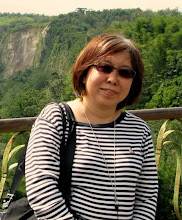With the latest
news that Perak is keen to revive its tin mining industry with the help of an Australian
company after the industry collapsed about 30 years ago, my visit to Matang Museum on 23 November
was timely as it took me back to where it all started in Taiping or Larut as it
was known then in the 1840s.
It had to do
with the pet elephant Si Larut that belonged to Che Long Jaafar, son of a minor
chief in Perak. Thus, when you
enter Matang Museum, you are greeted by a diorama of Si Larut with Long Jaafar and his men looking at the tin ores which were accidentally discovered in 1848 when they were found embedded in mud on the legs
of this elephant which had gone missing for three days. It is believed that
Larut obtained its name from Long Jaafar’s elephant.
Thus, when you
enter Matang Museum, you are greeted by a diorama of Si Larut with Long Jaafar and his men looking at the tin ores which were accidentally discovered in 1848 when they were found embedded in mud on the legs
of this elephant which had gone missing for three days. It is believed that
Larut obtained its name from Long Jaafar’s elephant.
According to
the text provided in the museum, Long Jaafar was also credited later for bringing
the first group of Chinese miners from Penang to work in the tin mines in Klian
Pauh as the Malays “lacked knowledge in tin mining”.
The influx of
Chinese miners in the state later saw the emergence of two clans, the Ghee Hin and the
Hai San, (which I remember studying in my history lessons during my secondary
school days) and the start of the Larut Wars between them. The three Larut
Wars, captured like pages from a comic book at the museum, attracted my
attention.
When Long
Jaafar died, he was succeeded by his son Che Ngah Ibrahim, who was instrumental
in settling the first Larut War (1861-62) dispute between the two Chinese clans.
The latter was granted the Orang Kaya Menteri title by the Sultan of Perak.
He built his
residence and fort, which is now the Matang Museum.The place has an interesting
history as it had been used as Larut’s administration centre by our British colonial
master and during the Japanese Occupation to store tin and farm produce.
The British had
used it as a prison to house Malay nationalists who fought against their
administration.
They included Datuk Maharaja Lela and his followers who were
involved in the murder of Perak’s first British Resident JWW Birch in Pasir
Salak. They were held here before their hearing. The prison is depicted
in one section of the museum, whose building had been turned into a teacher’s
training institute and Malay school before its current use.
Upgrading works,
which covered within and outside the first floor of the building, was on-going
when our group visited it under Jelajah Media @Muzium, which was organised by
Jabatan Muzium Malaysia although our invitation had come from the Ministry of
Tourism, Arts and Culture’s (MOTAC) Corporate Communication Unit.
The upgrading exercise
had started on 9 November and should be completed by 29 November, according to
a signboard placed at Matang Museum. As a result, our visit was limited to its
ground level. Well, that’s a good reason to return here for another visit in the
near future.
Admission to the museum is free. It is open daily from 9am to 5pm except on the first day of Hari Raya Adilfitri and Hari Raya Adiladha.
Admission to the museum is free. It is open daily from 9am to 5pm except on the first day of Hari Raya Adilfitri and Hari Raya Adiladha.








No comments:
Post a Comment